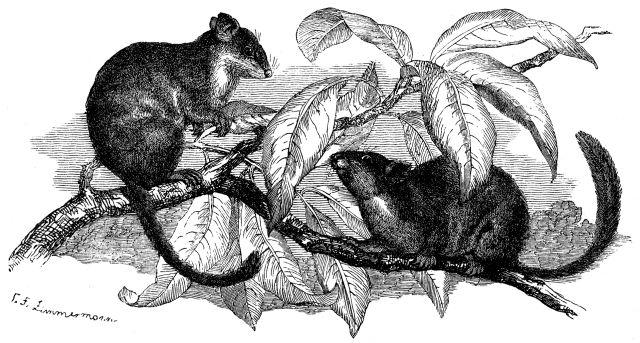Feathertail Glider (Acrobates pygmaeus) - Wiki Feathertail Glider
From Wikipedia, the free encyclopedia
[Photo] taken from: Brehms Thierleben. Allgemeine Kunde des Thierreichs, Dritter Band, Erste Abtheilung: S??ugethiere, Zweiter Band: Raubthiere, Kerfj??ger, Nager, Zahnarme, Beutel- und Gabelthiere, Zweite umgearbeitete und vermehrte Auflage, Kolorirte Ausgabe, Leipzig: Verlag des Bibliographischen Instituts, 1883. (CD-ROM by directmedia Berlin, Permission to use is given)
The Feathertail Glider (Acrobates pygmaeus), also known as the Pygmy Gliding Possum, is the world's smallest gliding mammal, and is named for its long feather-shaped tail. Although only the size of a very small mouse (65 to 80 mm and 10 to 14 g), it can leap and glide long distances from tree to tree, up to 25 metres. Like other gliding mammals, the Feathertail Glider has a skin membrane between the fore and hind legs; thicker than that of the other marsupials like the Sugar Glider, but smaller in proportion, extending only between the elbows and knees.
The most obvious feature of the Feathertail Glider, however, is the tail that gives it its name: it is about the same length as the combined head/body, quite thin, moderately prehensile, and almost hairless except for the two very obvious rows of long, stiff hairs on either side. The tail, when held straight, looks rather like a double-sided comb. It is used to grip twigs and small branches, and to control gliding flight: steering and then braking.
The coat is a uniform mid-grey, with dark patches around the eyes and often a white patch behind the ears. The underside is lighter; the ears are moderately large and rounded.
The natural habitat of the Feathertail Glider is the eastern seaboard of Australia, and the glider's distribution is from North-Queensland to Victoria.
The Feathertail Glider's diet includes nectar, pollen and arthropods.
Coins to medals
The Feathertail Glider was featured on the Australian 1 cent, until it was withdrawn from circulation in 1991. The 1 cent coins, along with the 2 cent coins, were later melted down to make bronze medals for the 2000 Summer Olympics in Sydney.
http://en.wikipedia.org/wiki/Feathertail_Glider
| The text in this page is based on the copyrighted Wikipedia article shown in above URL. It is used under the GNU Free Documentation License. You may redistribute it, verbatim or modified, providing that you comply with the terms of the GFDL. |
